
Falmouth is a town, civil parish and port on the River Fal on the south coast of Cornwall, England, United Kingdom. It has a total resident population of 21,797.
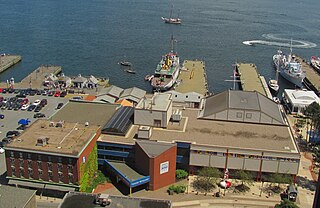
The Maritime Museum of the Atlantic is a maritime museum located in downtown Halifax, Nova Scotia, Canada.
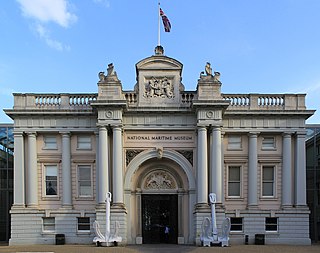
The National Maritime Museum (NMM) is a maritime museum in Greenwich, London. It is part of Royal Museums Greenwich, a network of museums in the Maritime Greenwich World Heritage Site. Like other publicly funded national museums in the United Kingdom, it has no general admission charge; there are admission charges for most side-gallery temporary exhibitions, usually supplemented by many loaned works from other museums.
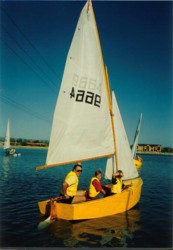
The Heron Dinghy is a dinghy designed by Jack Holt of the United Kingdom as the Yachting World Cartopper. The Heron dinghy was designed to be built by a home handyman out of marine ply over a timber frame, but can now also be constructed from marine ply using a stitch and glue technique or from Fibreglass. Modern dinghies will usually have built in buoyancy tanks, older craft will have bags or retrofitted tanks.

Henry Scott Tuke, was an English artist; primarily a painter, but also a photographer. His most notable work was in the Impressionist style, and he is best known for his paintings of nude boys and young men.

The Wayfarer is a wooden or fibreglass hulled fractional Bermuda rigged sailing dinghy of great versatility; used for short 'day boat' trips, longer cruises and for racing. Over 11,000 have been produced as of 2016.

Portloe is a small village in Cornwall, England, on the Roseland Peninsula, in the civil parish of Veryan. Portloe harbours two full-time working fishing vessels, the Jasmine and Katy Lil, which fish for crab and lobster in Veryan and Gerrans Bay, and a fleet of smaller leisure boats in summer. Visitors are attracted to Portloe by its fishing, scenery, and walks.

The International 14 is a British racing sailboat, crewed by two sailors. The class was established in 1928.

The Merlin Rocket is a 14 foot (4.3 m) dinghy sailed in the United Kingdom. It is an active class, now with over 3800 boats built.

The Royal Cornwall Polytechnic Society is an educational, cultural and scientific charity, as well as a local arts and cinema venue, based in Falmouth, Cornwall, England, United Kingdom. The Society exists to promote innovation in the arts and sciences.
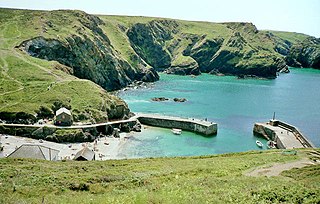
Mullion Cove, or Porth Mellin, is a small community on the West Coast of the Lizard Peninsula in Cornwall, England, and on the eastern side of Mount's Bay. The Cove forms part of the parish of Mullion, and is accessible by road from Mullion village, 1 mile (1.6 km) to the northeast, and also via the South West coast path. It lies within an Area of Outstanding Natural Beauty.

The Ferriby Boats are three Bronze-Age British sewn plank-built boats, parts of which were discovered at North Ferriby in the East Riding of the English county of Yorkshire. Only a small number of boats of a similar period have been found in Britain and the Ferriby examples are the earliest known sewn-plank boats found in Europe, as well as the oldest known sewn-plank boats in the world outside of Egypt.
The Falmouth Quay Punt was a type of working sailing vessel in the port of Falmouth, Cornwall in the 19th and early 20th century. They would be hired by merchant ships anchored in Carrick Roads – to carry stores, mail and passengers. Falmouth, with a good deep water harbour situated near the Western entrance to the English Channel, was a popular port for merchant sailing ships to call "for orders". Before the days of radio, captains would often not know which port their cargo would be destined for before they arrived in the country, and needed to collect instructions before continuing.
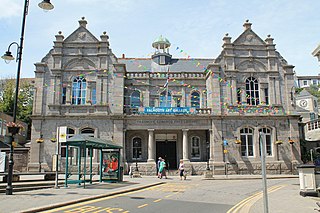
Falmouth Art Gallery is a publicly funded art gallery in Cornwall, with one of the leading art collections in Cornwall and southwest England, which features work by old masters, major Victorian artists, British and French Impressionists, leading surrealists and maritime artists, children's book illustrators, automata, contemporary painters and printmakers. It is located on The Moor, on the upper floor of the Municipal Buildings above the Library in Falmouth, Cornwall.
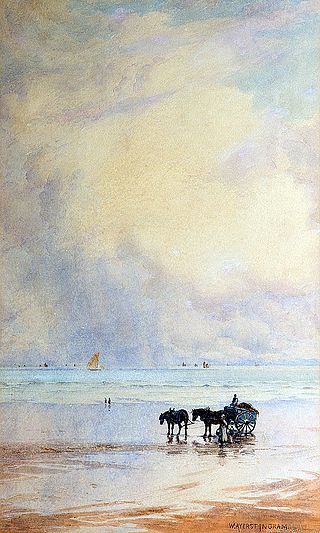
William Ayerst Ingram or W. Ayerst Ingram RBA was a painter and member of the Newlyn School. He did notable Landscape art and Marine art. In 1906 he joined the Royal Institute of Oil Painters and in 1907 he joined the Royal Institute of Painters in Water Colours.
Frank Charles Dye was a sailor who, in two separate voyages, sailed a Wayfarer class dinghy from the United Kingdom to Iceland and Norway. An account of this was written by Dye and his wife, Margaret, published as Ocean Crossing Wayfarer: To Iceland and Norway in a 16ft Open Dinghy.

Fishing in Cornwall, England, UK, has traditionally been one of the main elements of the economy of the county. Pilchard fishing and processing was a thriving industry in Cornwall from around 1750 to around 1880, after which it went into an almost terminal decline. During the 20th century the varieties of fish taken became much more diverse and crustaceans such as crab and lobster are now significant. Much of the catch is exported to France due to the higher prices obtainable there. Though fishing has been significantly damaged by overfishing, the Southwest Handline Fishermen's Association has started to revive the fishing industry. As of 2007, stocks were improving. The Cornwall Sea Fisheries Committee is one of 12 committees responsible for managing the corresponding Sea Fisheries District. The Isles of Scilly Sea Fisheries Committee is responsible for the Scilly district.
The Water Wag is the oldest one-design dinghy in existence, having been devised in 1886 and formalised as a one-design class in Ireland in 1887. It was last modified in 1900. The class is still sailed to this day, notably with large Water Wag fleets racing during summer evenings from Dún Laoghaire harbour on Dublin Bay. The Water Wag class is administered by the Water Wags club, based in Dún Laoghaire.

A foyboat is a small vessel primarily used to assist the mooring and servicing of a larger vessel. It is not a tug per se. The word has often been associated with the rivers of North East England.

















